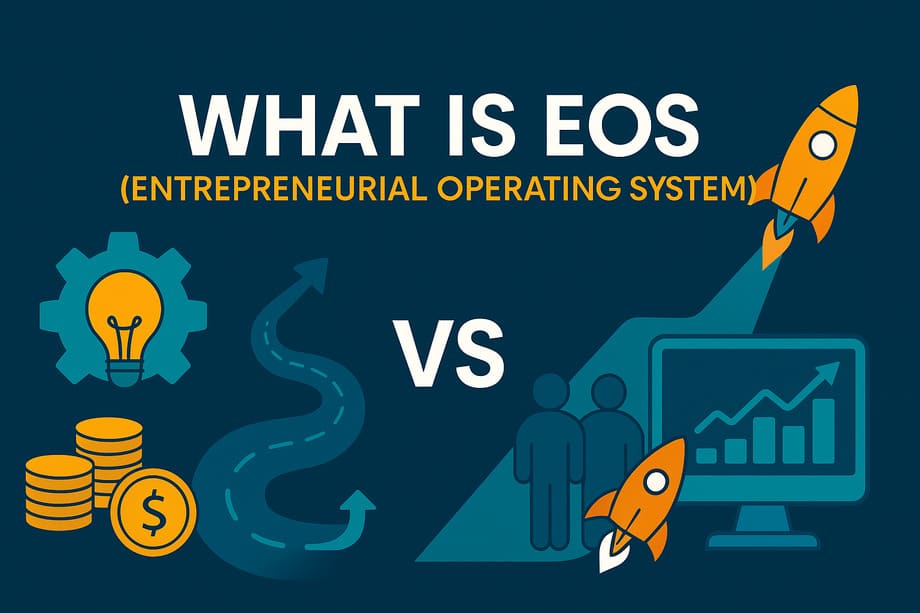Running a business is challenging. Many entrepreneurs struggle with aligning teams, setting priorities, and building accountability. The Entrepreneurial Operating System (EOS) provides a practical framework that helps leaders get more out of their business by improving structure, focus, and execution.
In this guide, we’ll explain what EOS is, why companies use it, and how you can implement it in your organisation.
What is EOS?
EOS, or the Entrepreneurial Operating System, is a set of simple, practical tools designed to help businesses achieve clarity, alignment, and growth.
Created by Gino Wickman, EOS is outlined in his book Traction. It’s not software, but rather a business management system that combines proven processes to improve focus and results.
The Six Key Components of EOS
EOS is built around six interconnected components. When strengthened together, they help companies run smoothly and scale effectively.
1. Vision
Defining a clear vision ensures everyone in the organisation understands where the business is going and how it will get there. EOS uses tools like the Vision/Traction Organizer (V/TO) to simplify this process.
2. People
Success depends on having the right people in the right roles. EOS focuses on accountability charts (different from traditional org charts) to align roles with responsibilities.
3. Data
Instead of relying on opinions, EOS encourages businesses to run on numbers. A weekly scorecard with key metrics ensures leaders can track performance at a glance.
4. Issues
Every company faces obstacles. EOS provides tools to identify, prioritise, and solve problems permanently using an Issues List and the IDS process (Identify, Discuss, Solve).
5. Process
Documenting core processes creates consistency and efficiency. EOS simplifies operations by ensuring everyone follows the same steps for critical activities.
6. Traction
This is about execution and discipline. EOS promotes setting clear 90-day goals (called Rocks) and holding regular Level 10 Meetings to stay accountable.
Why Businesses Use EOS
- Clarity – Everyone knows the company’s goals and direction.
- Accountability – Team members understand their roles and responsibilities.
- Focus – Priorities are narrowed down to what really drives results.
- Problem-Solving – Issues are addressed instead of ignored.
- Growth – Businesses can scale more effectively with strong foundations.
Who Can Benefit from EOS?
EOS is designed for entrepreneurial businesses with 10–250 employees, but the principles can apply to startups and larger organisations too.
It’s particularly useful for companies that:
- Feel stuck or misaligned.
- Struggle with communication across teams.
- Want to improve execution and results.
How to Implement EOS
- Learn the basics – Read Traction or explore EOS resources.
- Use EOS Tools – Start with the Vision/Traction Organizer, Accountability Chart, and Rocks.
- Run Level 10 Meetings – Weekly meetings that improve focus and problem-solving.
- Consider a Professional Implementer – Many businesses hire EOS Implementers to guide them.
- Stay consistent – EOS only works if the tools are used regularly and applied across the whole business.
Common Challenges with EOS
- Leaders not fully committing to the system.
- Inconsistent use of tools and frameworks.
- Resistance from team members used to old habits.
Overcoming these requires discipline, transparency, and strong leadership buy-in.
FAQs
Is EOS software?
No. EOS is a business management framework, not a software product.
How long does it take to see results with EOS?
Many companies see improvements within 3–6 months, with significant traction after a year of consistent application.
Do small startups need EOS?
While EOS is aimed at SMEs, startups can still benefit from its structure, especially when planning for growth.
What’s the difference between EOS and OKRs?
EOS is a complete operating system covering vision, people, processes, and execution. OKRs are goal-setting frameworks that can complement EOS.
Final Thoughts
The Entrepreneurial Operating System (EOS) gives leaders a practical way to run their businesses with more focus, accountability, and growth potential. By strengthening the six key components, Vision, People, Data, Issues, Process, and Traction, companies can overcome challenges, align teams, and achieve better results.
If your business feels stuck or chaotic, EOS might be the framework that brings structure and clarity to take it to the next level.

Leave a Reply